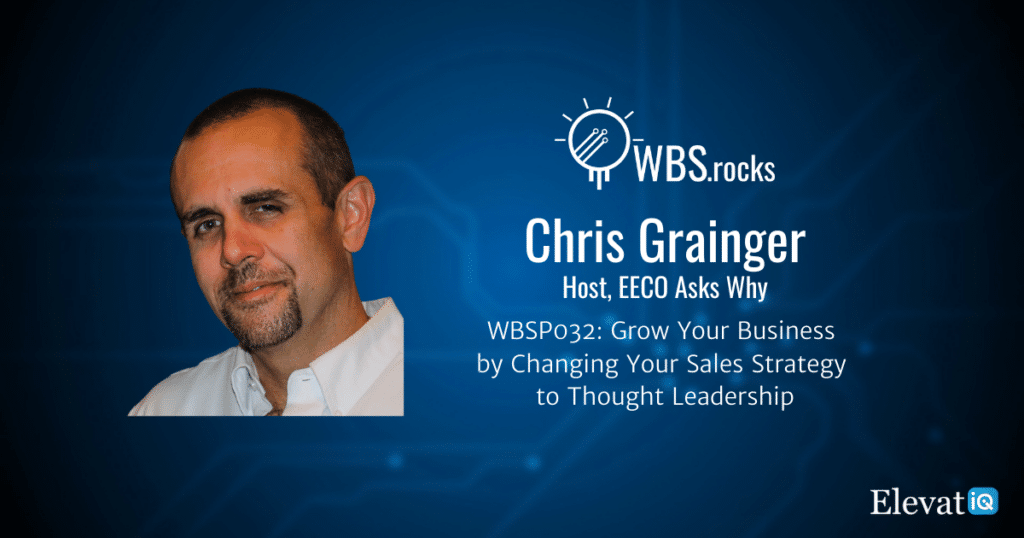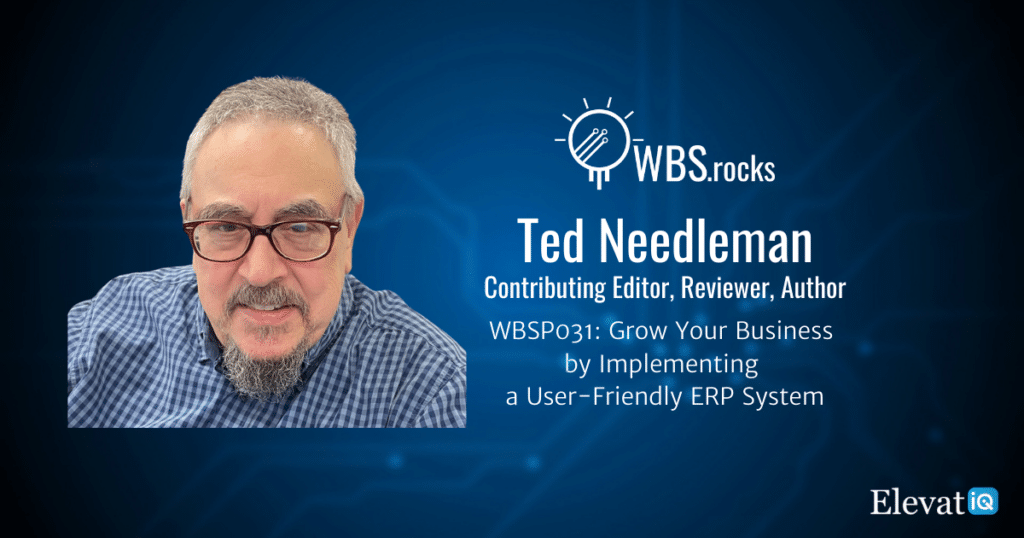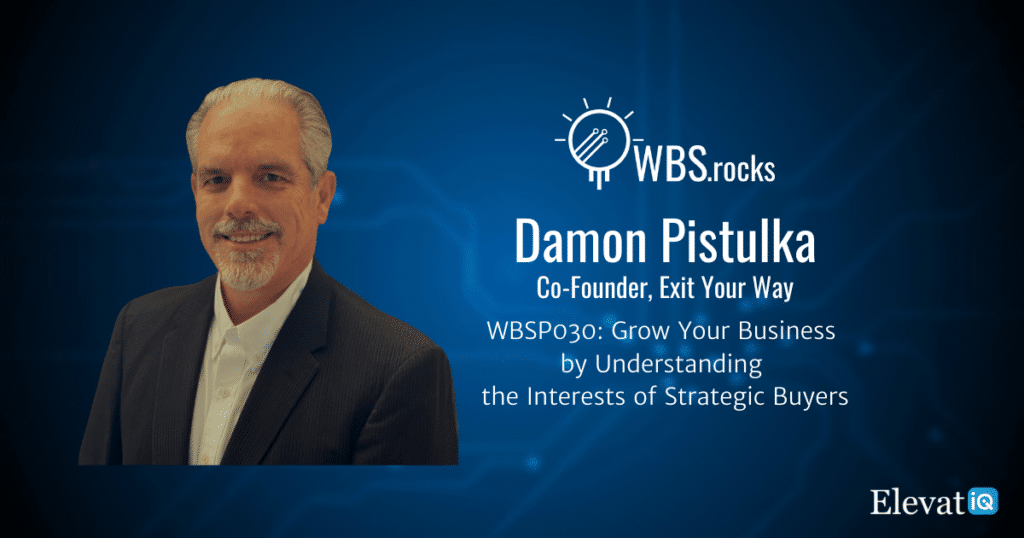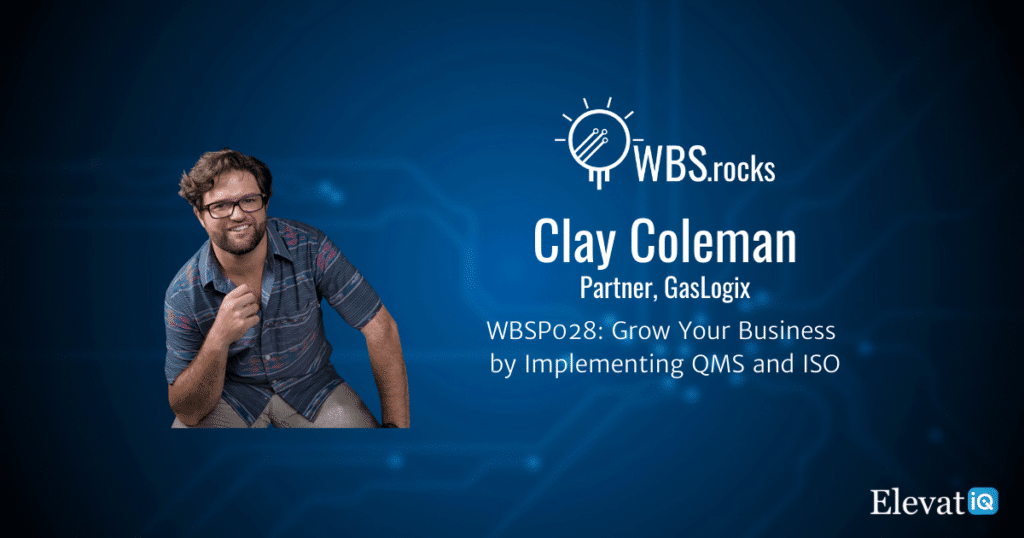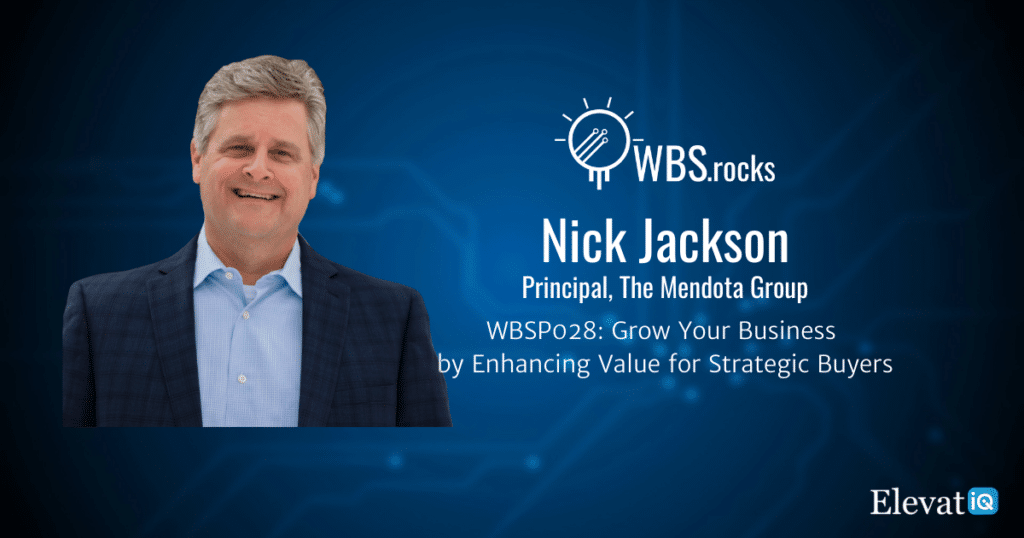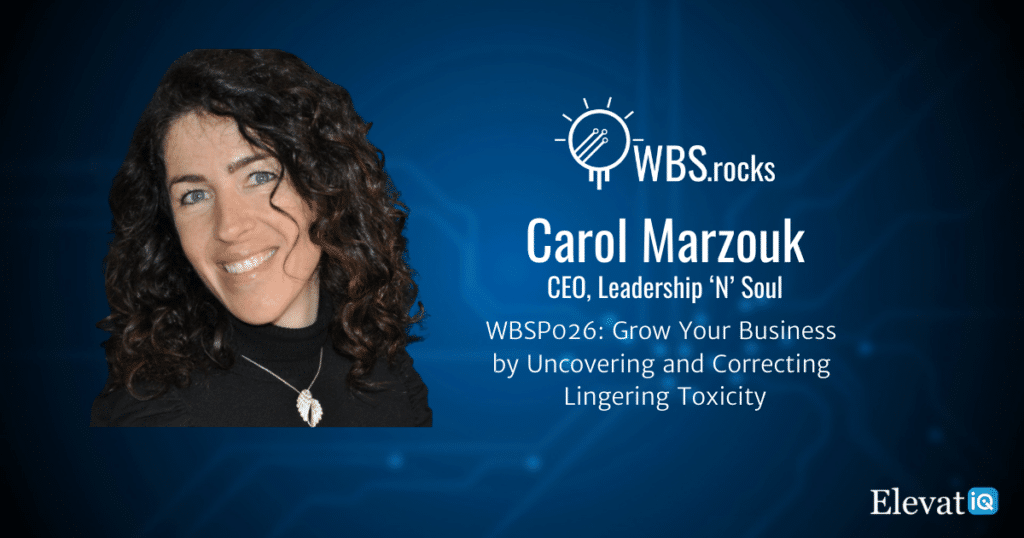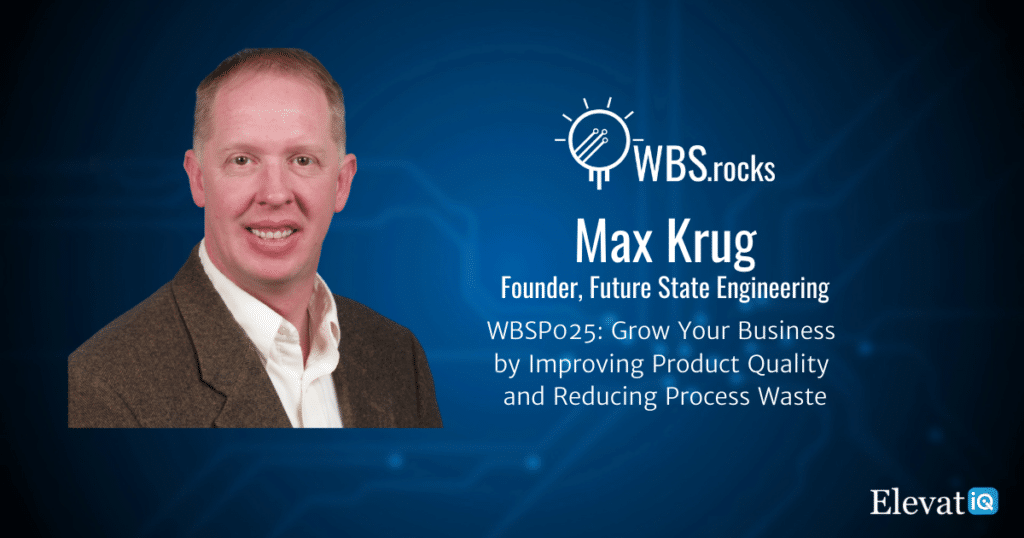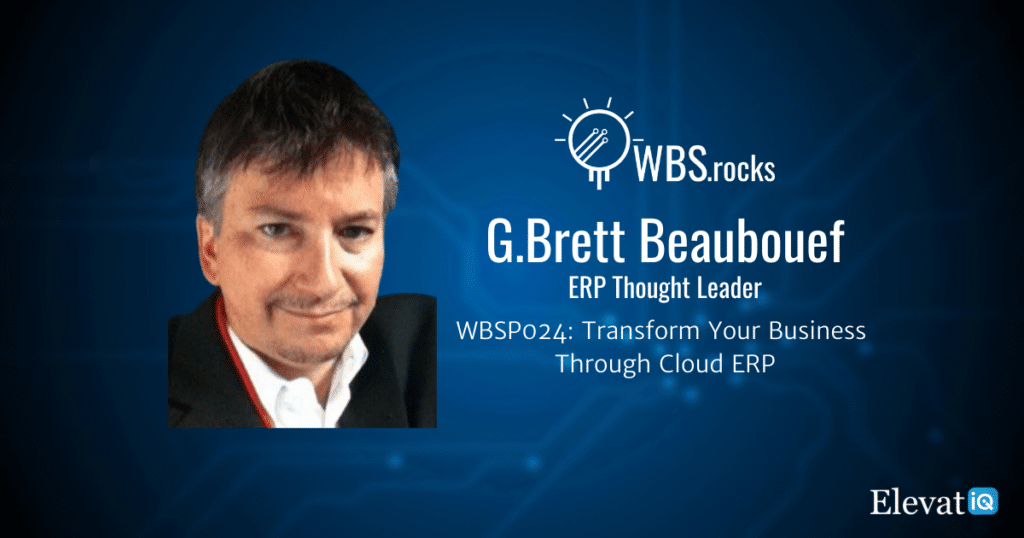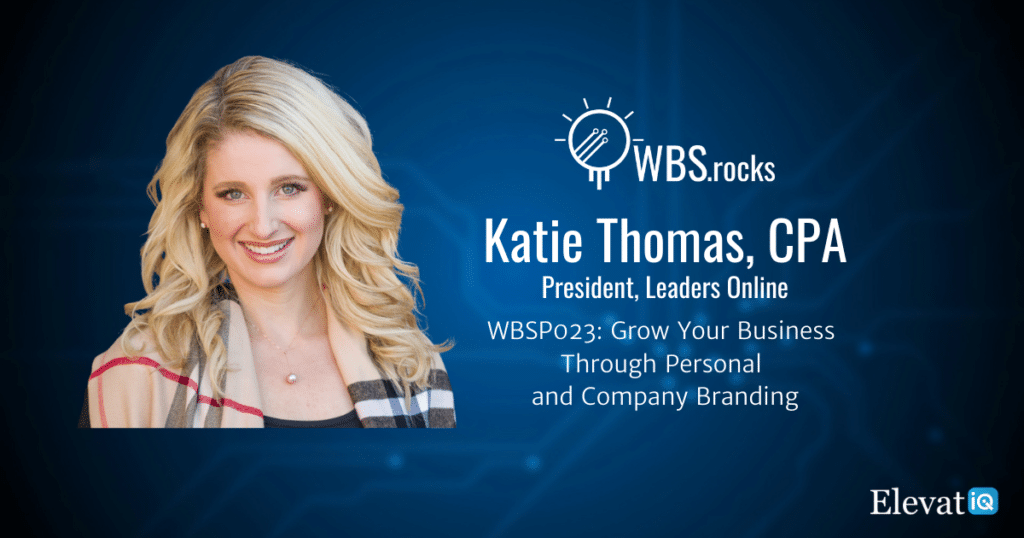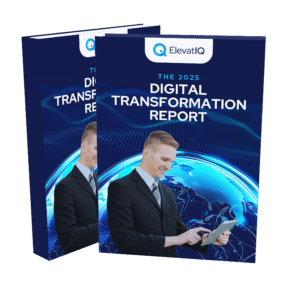WBSP032: Grow Your Business by Changing Your Sales Strategy to Thought Leadership w/ Chris Grainger
In this episode, we have our guest Chris Grainger, who discusses how his company EECO, a large electrical distributor, needed to change the way they sold to their customers. He also touches on how they started their journey of thought leadership, highlighting heroes in their community, which has helped them strengthen their position in the market and acquire net new business in a whole new different way.
Chapter Markers
- [0:15] Intro
- [2:07] Personal journey and current focus
- [3:27] Perspective on growth
- [4:38] Chris’ podcasting journey
- [6:26] Who should lead thought leadership initiatives?
- [7:57] How to find thought leaders to lead content strategy?
- [9:29] How can thought leaders balance their priorities?
- [13:20] Content consumption behaviors and trends
- [14:51] Finding business from thought leader strategy
- [17:03] How manufacturers can start on a thought leadership journey
- [21:06] The role of industry influencers
- [31:59] Closing thoughts
- [34:17] Outro
Key Takeaways
- If you want it to really get out in front and serve your industry the best, you better be figuring out how to do it via video and be a podcast. You know that that’s really two really good mediums to work through.
- A manufacturing business, or business in general, you need to understand the value you’re bringing to the market you’re trying to serve, and the questions they’re asking, and answer those the best you can, and if you do that, then you will bring so much value.
- If a company wants to be that thought leader and get out in front of things, you got to look at your subject matter experts. They should be the ones leading a lot of the efforts and getting behind it.
- The way you consume content and just what YouTube has done for the world over the last couple of years. You know you want to learn how to do anything. You, you pick it up and go to YouTube, and you figure it out, and you need to be there. So somebody, if you’re in the B2B space, one thing that I’m spending a lot of time on right now is, what are the questions that the markets asking? And then, I want to be the thought leader in answering those questions.

Subscribe and Review
Apple | Spotify | Stitcher | Google Podcasts | Deezer | Player FM | Castbox
About Chris
Chris Grainger has been supporting the industry for 20 years. His passion is serving others and creating strategies to support the changing needs of manufacturing. He hosts the podcast EECO Asks Why which highlights the ideas and heroes that serve the industry with aspirations to inspire others.
Resources
Full Transcript
Chris Grainger 0:00
My approach with the executives was every company is a media company. It’s just we sell different stuff. So we had to figure out different ways to approach the market, and this is the way did they graciously.
Intro 0:15
Growing a business requires a holistic approach that extends beyond sales and marketing. This approach needs alignment among people, processes, and technologies. So if you’re a business owner, operations, or finance leader looking to learn growth strategies from your peers and competitors, you’re tuned in to the right podcast. Welcome to the WBS podcast, where scalable growth using business systems is our number one priority. Now, here is your host, Sam Gupta.
Sam Gupta 0:50
Everyone, welcome back to another episode of The WBS podcast. I’m Sam Gupta, your host, and principal consultant at this transformation consulting firm, ElevatIQ. The last three years have changed the way businesses operate, with podcasts and videos becoming the most consumed media for information consumption. But 80% of the B2B sales decisions are being influenced by industry influencers and consultants. Today’s businesses need to be thought leaders in their space, but who drives thought leadership in a company?
In today’s episode, we have our guest, Chris Granger, who discusses how his company EECO, a large electrical distributor, needed to change the way they sold to their customers. He also touches on how they started their journey of thought leadership, highlighting heroes in their community, which has helped them strengthen their position in the market and acquire net new business in a whole new different way. Let me introduce Chris to you.
Sam Gupta 1:43
Chris Granger has been supporting the industry for 20 years. His passion is serving others and creating a strategy to support the changing needs of manufacturing. He hosts the podcast EECOAsksWhy, which highlights the ideas and heroes that serve the industry with aspirations to inspire others. With that, let’s get to the conversation. Hey, Chris, welcome to the show.
Chris Grainger 2:05
Thank you, Sam.
Sam Gupta 2:07
So just to kick things off. Do you want to start with your personal story? And what are you focusing on these days?
Chris Grainger 2:14
Oh, absolutely. I went to Old Dominion University in Virginia and studied electrical engineering. And from there, I had a great opportunity to work for an electrical equipment company was a wholesale distributor servicing the industrial market in the southeast US. I’ve had many different roles at EECO, what we call it, and one of the most recent projects that I’ve been very blessed to be a part of is we were able to start a podcast at EECO called EECOAskWhy. And we focus on the people. And the ideas out there that that are leading industry and getting a lot of topics and guests out there to share their stories because we really feel that they are the heroes.
So that’s been a wonderful adventure and something that has really been just taken such a big piece of my heart and to serve others with this. And I actually got that started by working with our executives. I know you customize a lot of your message to executives out there. And my approach with the executives was every company is a media company. It’s just that we sell different stuff. So we had to figure out different ways to approach the market. And this is the way that they graciously let me try. And we’ve seen some really good results since then.
Sam Gupta 3:27
Okay, amazing. So I want to touch on a lot of different topics there especially related to changing the mindset of the media company. And obviously, my target audience is going to be CFOs and CEOs. Sometimes they don’t really understand what media company means. So we are going to dig into that. But before that one question that we asked, every single guest that we get here is going to be your perspective on growth. What does growth mean to you, Chris?
Chris Grainger 3:51
Growth means to me. It’s always moving forward and having an open mind to understand the changing landscape of what’s around you. If you look at B2B, and that’s the industry that serves in is the B2B industry. Since when COVID impacted it, things have been completely flipped upside down. And to be in the have a growth mindset, you have to understand, hey, the things have changed. And what do I need to change the way that I approach my work? Or how do I support people? Or just how customers or clients need support in the future? How is all that changing? Because I have to add value to that. And maybe the value that I had a year ago, pre-COVID, is not the value that customers and clients need right now. So growth to me is just that growth mindset of always being evaluating and willing to change.
Sam Gupta 4:38
So now, let’s talk about your story. Obviously, you started the podcast for a reason. And you mentioned that your goal is to find heroes from the community. So obviously, our CFO and CEO roles out here, we like to see numbers, and obviously, you know, we want to serve the community. But we also want to serve our customers, and we need to have a business plan behind that. So what was the genesis of your podcast? What was the thinking behind that? What were the changes that you were monitoring in the market, and what are you trying to get out of it?
Chris Grainger 5:13
Sure. I mean, from what we saw, customers were changing the way that they’re consuming content. If you look at the industrial market, there’s a lot of information out there that you can get straight from manufacturers, but we’re the distributor, we’re the middle guy. So we need to be the ones leading the message for our customers and serving them the best way we can with thought leadership.
And I started valuing, and listening to a lot of things and studying, listening to a lot of Gary V and understanding things that he’s promoting from, from a media standpoint, and just really apply that to say, okay, to our business, we’re not doing this, nobody’s doing this, nobody’s talking about these things. It’s just the same old traditional way about business for the vertical that we’re in. And we had a great chance to get out front and really lead the way and not that we just want to leave everybody behind.
But hey, we need to go. We want to go where they’re going and where our customers are going and help them in ways they hadn’t considered. And that has been the biggest impact for us. And so when we start talking from I know, you talk about CEOs and CFOs, from an impact standpoint, I think for them, it’s been, hey, what were the thought leaders here, and when you’re a thought leader in whatever space you’re in, that’s gonna have financial impacts at the end.
Sam Gupta 6:26
Okay. So when I look at your background, I mean, you were not part of the marketing department. Typically, these initiatives are led by the marketing department, right? So in your case, when you started this initiative, so obviously, you know, every company needs to be a media company, I get it. So when we look at our manufacturing and distribution landscape, where should the mindset start? In terms of starting these initiatives?
Chris Grainger 6:51
Most of the time, it does start in the marketing departments, you know, because you’re right, that’s where a lot of that that creativity, if you will, it’s not always engineering, like with my background, but yeah, you know, that’s okay. But I will say, for us, I have a colleague, that he’s our executive producer, Adam sheets, he’s my number one guy, and he really helps me on a lot of the production aspects. But really, I think if a company wants to be that thought leader and get out in front of things, you got to look at your subject matter experts; they should be the ones leading a lot of the efforts and getting behind it.
And that just takes a different type of thinking. And there are a lot of resources that I studied, continue to study out there to help me evaluate where I’m at and where I want to go. How can I bring the most value to the market? How can I that bring the most value to my employer and ultimately serve the people that I want to serve the best and? And I think that that approach really led us down this unique path where someone in engineering is leading the charge, if you will, for a podcast to serve the market.
Sam Gupta 7:57
So in your case, how did this all start? If I look at your company, the size of the company is fairly large. Right? And I don’t know if you were their top subject matter expert. How did they pick you to start this podcast?
Chris Grainger 8:11
Well, I think that, basically, it was the default. So I actually pitched it to the executives. I had our CEO and a vice president of sales. And I just set them down with our marketing managers. I had a business plan laid out on how I felt like this needed to happen, you know, the little capital we needed upfront to get it going. And a list of topics. I think I started the list with 20 or 30 topics I thought we could talk about and since and they gave the nod and said, do you think you can do it and I put my head down, I said, I think I can, I’d love to have a chance.
You know, and looking back now, we’ve interviewed so many guests, and 100, probably 150 or plus, but actual recordings, and we’re up to almost 70 episodes out right now. And we’ve increased our cadence to twice a week of four drops. So it’s been really wonderful. I’ve had a great chance to meet wonderful people just like yourself, Sam, and the podcast. It’s just it naturally connects you to so many people, you know, CEOs and high-level executives all the way down. For me, I get the most pleasure out of working with the guys that are into the plant, the girls that are in the plant. They’re the ones that are on the floor. We actually interview them as well. And that’s what brings me so much fulfillment out of doing the podcast.
Sam Gupta 9:29
So let’s say if I’m looking at one of the engineering managers in my manufacturing organization. Typically their days are going to be super occupied, and they need to report whatever they are working on. Right, in addition to that, the podcast is a humongous amount of work. I mean, it’s not an easy task at all. Each episode that we produce requires 20 hours of work. To be honest, that’s how much work it takes to produce a podcast. It’s not easy. So in your case, and I don’t know, you know, what was the personal driver you said that you were listening to a lot of shows from Gary V, which could be very inspirational, I get it. But again, considering the amount of work involved, what was the major personal driver for you to undertake such a heavy responsibility?
Chris Grainger 10:12
I needed a project moving forward that I could put my heart into, and quite frankly, just selling parts and being a distributor tied to a lot of commodities, which was not fulfilling for me. So I needed to find a way to have a greater impact, you know, on a greater community, and try to give people a voice that I feel I’ve heard these voices for years as servicing the market, but I’ve never just one on one. So this gave me an opportunity to amplify that voice and get out there and give me something that I really felt aligned with, with my career goals, the things I’d like to be learning about, you know, I was one of those engineers, man that I did the engineering work, I did the math, I got the diploma, I did all the work, but I’ve never really had the passion for being the actual the engineer who’s doing the design work.
I’m much more rather be networking or helping people achieve their goals and working alongside versus being tied to a cubicle doing, you know, PLC programming, for instance. So it was just a natural fit for me in what I desire for my career. It’s a take a path like this and learn skills like this. And this led to now new skills like video and an understanding how video editing and trying to bring that component to fruition, because you’re right, it’s a lot of work for every podcast episode if you treat the guests the way that they should be treated.
And we do blogs, a lot of social media posts, and then repurpose all the content and make case studies where we can where I’m writing three case studies right now based on some of some conversations we’ve had. So it’s just it really consumes you. But if it’s work that you’re passionate about, you know, you find the time, and you make the priority.
Sam Gupta 11:52
So what are there any compromises in your job responsibilities? Do you still have that job that you were doing on a daily basis? In addition to that, are you able to do this as well?
Chris Grainger 12:01
Yeah, so I’m still an engineering and services manager, I think what it does for you, as your responsibilities go up, and time crunch goes up, you learn to delegate, and you learn how to manage basically, this podcasting is just like any engineering project, you manage it, just like that. And if you have a schedule, and you have a process, and you get it defined, and you block that time, it works, you know, so you just have to work that into the regular work that you’re doing that while the other work that you’re doing, because this is the work, you know, and it all falls in alignment, I still have monthly one on ones with every one of my direct reports, we still have dashboards, we still have all our metrics, and I have automated a lot of that stuff.
So that the numbers that are important for us to be chasing are in front of us all the time, so my just my engagement with my team is a lot more meaningful, more impactful, but also understand to do this right. And to do video, right, and to do blogs, right? and case studies, right? You better dedicate time to it, or it’s just gonna be halfway done with no value to people out there that are consuming it. And then, you know, nobody’s gonna get any value from it. And that point, why are you even doing it? So just it really, if you approach it like an engineering project, I think for me, that’s been the biggest thing and just defining that process.
Sam Gupta 13:20
Okay, amazing. So you did mention during your introduction that the market is changing, and the way our leadership is working in the market, the kind of messaging customers like to hear at this point of time is completely different. So what are some of the things that you have noticed that have changed in the market in the last two, three years,
Chris Grainger 13:39
So much more is going to video, man. I mean, that’s, we’re seeing so many of our vendors, we support getting messages out via video. And that’s something I’ve just been doing so much studying on about how to get. You want to be a thought leader. If you want it to really get out in front and serve your industry the best, you better be figuring out how to do it via video and be a podcast. You know that that’s really two really good mediums to work through.
Because just think about the way you consume content and just what YouTube has done for the world over the last couple of years. You know you want to learn how to do anything. You, you pick it up and go to YouTube, and you figure it out, and you need to be there. So somebody, if you’re in the B2B space, one thing that I’m spending a lot of time on right now is, you know, what are the questions that the markets asking? And then, I want to be the thought leader in answering those questions.
I really don’t care about the features and benefits and all this other stuff, at least because everybody’s got that feature and benefits that they can do for you. I care about what are the end-users? What are the people out there in the market? What questions are they asking because they’re the ones I want to answer. And if I answered them openly and honestly, with a servant’s heart, the business will follow.
Sam Gupta 14:51
I’m a CFO here. Okay, Chris, and let’s say if you are trying to pitch me an idea or my team is trying to pitch me an idea. Obviously, I have a job to do. I would love to serve the community, but I need to do my job as well. And my job is to maintain the top line as well as the bottom line, right? So let’s say if you’re pitching me an idea, in your case. Obviously, you are a superhero, Chris, that you are able to do your job, you are able to do the podcast, you are able to build the content.
But let’s say if I am running a manufacturing shop, as a CFO, I’m not gonna find another place, to be honest. Okay, I need to find some budget to be able to run this initiative. And I need to know the ROI from the initiative. So in your case, have you been able to find any business using this effort?
Chris Grainger 15:38
Yeah, absolutely. And it came down to, for us, a couple of our actual guests that we came that we were able to bring on have, since then brought us in to have deeper business conversations to actually expand our business. Some of them we’ve never even done business with before. And now that they go through this experience, we help them figure out something about their market, right. They liked it so much. And as a connector, and you know, this very well, Sam as a connector, I’m watching who’s watching. Then, when they when I see that they’re, they’re interested, or they like something, I’m reaching out to him.
And then, all of a sudden, next thing, you know, we’re building that relationship even further. Because like I said before, the way pre COVID work for a B2B is not how it is now. So it’s the podcast that has given us opportunities to serve new clients, understand their needs, build trust, and we’re doing all this without ever setting foot actually in their plant.
And that when you think of it that way, nope, nobody’s done that. So that’s been for us in return for sure. And several pretty specific cases. But it’s been really neat to see how that works. And as it grew, we’re not even a year into the podcast for us. We’re still less than a year old. I’m so excited for where it can go because 2021 is the focus more actual in client conversations to understand what’s changing in the market.
Sam Gupta 17:03
Okay, so let’s say find the manufacturer or the distributor, and I sort of understand that there is going to be some value from the thought leadership, I’m not sure if I’m sold on it, okay, because, you know, you need to try before you can see some ROI. So what would be your recommendation in terms of starting on this journey?
Chris Grainger 17:20
I would probably really start with your blogging, really get good at blogs, answer the questions, again, that your market asks and answer them straight up and talk about, you know, the stuff like cost delivery, and it’s not about puking out what you’re great at, it’s about answering the question, right? Everybody wants to talk about how awesome they are versus, hey, this, let’s just answer the question because that’s, and then start monitoring that content.
There are all sorts of ways to do that. And we won’t get into that today, but see what’s working for you. But blogging, that’s something anybody can do. There’s no equipment required. People still consume a massive amount of written content. And then if you can get to be a thought leader in your space, by blogging, that’s going to open up avenues, particularly for us, we’ve noticed, like, if a blog takes off, you can bet your bottom line.
I’m going to be bringing that topic up on the podcast because, obviously, people are searching for it. And our number one most downloaded podcast happens to be our number one most downloaded blog. We linked them together. Now, every time that people open up that blog, they’re consuming our podcast, they’re learning more about us, we’re serving them at higher levels, and then the leads continue to come in.
Sam Gupta 18:31
Okay, so I like the pitch of our blog, that it’s not really expensive, because you don’t really require the gears, but not everyone is going to be an effective writer. And if that was the case, then everybody in this world would probably become an author, which is not the case. Right? And blogging is very expensive as well, it’s not easy, because if I asked my marketers, my writer is going to say, I’m actually going to charge you whatever $300 for a blog, that is probably going to be 500 words, and there is no promise for an ROI. Right? If I have the same pitch with the trade show, if I’m going for a trade show or something like that, I’m actually shaking hands. I’m making the conversations there. So why do you recommend that I should be writing a blog, and how do you see ROI from that?
Chris Grainger 19:19
Well, I’m gonna give you a reference that I think your audience may really find value in. And it’s a book written by Marcus Sheridan. It’s called they ask you to answer. And if you write the blogs and if you have a sales executive, CFO, CEO, and your focus is again, being serving your industry that at the to the top level that you can, what do you need to know? Well, you need to know the questions that whoever your end customer is, what they’re asking the heart of it, and then you focus on that.
Now, you’re right. Not everybody has top-level writers, but we all in whatever business we have had subject matter experts, a lot of times, the information is in everyone that works around our head. But you do have to gather that information. It could just be as simple as, as a brainstorming session, it can start off as just technical type documents, and then work with maybe you use up work or use different, outsource type of resources to get some marketing assistance to actually pretty it up, if you will, things like that.
But if you want to be the leader, you better find resources to get behind being a thought leader and content development because that’s the way the world is turning. And that’s why I said that that resource they ask you answer, you start walking through the principles of that book, and that guide if you will, that will put you where you need to be in making those decisions.
Because you know, it all starts with change. Next thing you know, you’ve got, you probably need a Content Manager, you maybe need a video choreographer that’s in your organization. And a lot of times, these types of roles aren’t thought about. But they better be because it’s changing so quickly. You better get it, you know, get on that train.
Sam Gupta 21:06
So what is the role of the influencer? So the more and more I’m noticing the market, Chris, the role of influence that is changing, especially in the B2B market, if we look at any of the expensive purchases, and I don’t know how expensive your equipment is, but in 90% of the deals that we come across in our space, they have some sort of influencer involved.
And obviously, these influencers are either social media, celebrities and again, social media celebrities don’t need to be somebody who’s doing fashion talk or music talk. They are either the manufacturing influencers or digital transformation influencers, or industry 4.0 influencers, and the more influence that they have, the more they’re influencing the deals. And there is a whole different ballgame here in terms of maintaining the relationship with the influencer. And the more we see LinkedIn the way it is going at this point in time, the way we see the podcast, and the video community the way it is going, I think influencers are going to be very relevant in the future. So what would be your thoughts on that? Do influencers matter? And how would you build relationships with the influencers?
Chris Grainger 22:14
So the answer does the influencers matter? Yes.
Sam Gupta 22:19
And why is it that because not every manufacturer cares for the influencer?
Chris Grainger 22:24
Why? Because again, look at how people consume content now and how they learn, and how they make decisions. I’ve read the stats all over the place, but somewhere between 70 and 80% of a buyer’s decision typically is made before they contact the distributor or the company directly. Why? Because they’ve consumed so much content online. So either you figure out a way, as a manufacturer of, or as a leader in the industry, to be out front in the content that they’re consuming, or you get left behind.
And if you’re a company like EECO like I work for, we don’t make anything, you know, we sell other people’s stuff, we are distributor, we are essentially the middleman between the manufacturer and the end-user. So for us, it’s even more vital to be that thought leader in helping get these topics and get in front of them and to be that thought leader for these topics for the industry, so that they see the value that we connect the dots that we can connect from for all the different types of solutions to bring to the table. So influencers are so important. If you start doing just like you’re doing with podcasting, and videos and blogs, and all that stuff, you connect, and you meet the influences, and next thing you know, you may be an influencer yourself as your network begins to grow.
Sam Gupta 23:39
Okay, so where do you see this going? I mean, obviously, podcasting is slightly newer compared to, let’s say, blog or video. But in the case of podcasting, I mean, right now, it is newer. So we have some categories, let’s say penetrated in specific niches or these spaces. But let’s see if everybody starts doing the podcasting. Do you think everybody is going to be equally successful with podcasting?
Chris Grainger 24:00
No, not at all. Because I think there are their stats out there. And, and a friend of mine, I believe he was on your show, Chris Luecke. He talked about the number. I can’t remember the percentage, but it’s over 50% of podcasts that start fail, and they never get past episode 10. So I mean, I think, you know, it sounds glorious and wonderful. You know, and I’ve talked to several people who are trying to start podcasts. And what I tell them is, you know, when the mics hot, that’s the fun part.
But there’s so much work before and after, and I related it to I used to work on race cars. And I told him, I said, you know, everybody shows up this on Sunday to see two cars out on a racetrack, but they don’t see all the work prior to leading up to, and they don’t see all the work afterward where you have to fix stuff to get tore up. Right. So it’s the same thing with podcasting. There’s so much pre-work and post-work if you want it to be successful and if you’re truly trying to serve people the right way. I think that’s what turns a lot of people off, man.
Sam Gupta 24:56
Okay, amazing. So let’s say we have this manufacturing value team, right. So you guys are distributors, and you see the value because you are not really carrying your product. You are slightly more marketing channel for your OEMs or the manufacturers. But do you believe that even for the manufacturers or retailers, they have to develop thought leadership as well? And if they do, you guys have sold similar products? Is there going to be any duplication in thought leadership when you and manufacturer retailers start doing the same thing?
Chris Grainger 25:27
I think it could be, but I think that’s good. I mean, I think the more you know, the more that manufacturers understand their fit. And that helps the distributor as not every distributor, Sam’s going to be like us and want to be the thought leader in and get out in front of a lot of us. Most distributors, rather, really want to just understand what the manufacturer’s features and benefits are and go talk about those because that’s easy.
So you know, we’re taking a much different approach. But I think any manufacturing business, or business in general, you need to understand the value you’re bringing to the market you’re trying to serve, and the questions that they’re answered that they’re asking, and answer those the best you can, if you do that, then you will bring so much value. And if there’s a crossover, I mean, there’s a crossover in what I do and what in what some integrators are doing. And I think there’s just, but that’s good. I mean, it’s just people are talking about these topics. And that makes it even more relevant.
Sam Gupta 26:21
Okay, so what is your perspective on some of these consulting businesses? So in the manufacturing ecosystem, we have a lot of consultants who don’t necessarily sell their physical products. They are primarily consulting. So do you believe that they should be answering these questions as well? And if they do, then what are they going to sell? Because that’s what they are selling?
Chris Grainger 26:41
Absolutely, they need to be answered, but they’re going to be selling, you know, you, you’re answering a lot of questions that people are asking, but at the end of the day, as a consultant, there’s still that one on one touch because everybody’s story is unique. Right? But you know, some of the high levels, the basic questions you get asked all the time if you were to lead that effort as a consultant, you know, and I’m trying to do this, I have another side hustle where I do financial consulting, or financial coaching on the side to help people and what my approach there is shifting to, I want to start asking the questions that people are, are asking about their personal finances, and just answer them and be the thought leader there.
And then from that, that’s gonna groom those leads. And when they come to me, they’re going to have a wealth of information that, hopefully, I’ve helped them with. But there’s still going to be dots that need to be connected, I think, as a consultant in any business, and just I just use mine as an example. That’s the value you bring you you connect the dots.
Sam Gupta 27:51
Okay, so you mentioned that you found a lot of heroes as part of your podcasting journey. So do you have any stories that you might be able to share of those needles? Do you want to highlight any of those?
Chris Grainger 28:03
They’re all so good. Sam, I had, you know, I guess one of the surprises I spoke to a gentleman, he was a president of a company in Virginia. And he has no social media presence. I think he has a LinkedIn account, but nothing else, an introvert, not very active. But just one of the most humble people I’ve ever met in my life.
His episode, man, it blew up like when we dropped it, it just all of a sudden a rocket ship. It came to show me how he’s such a servant leader. And he’s helped people so much throughout his career that they immediately wanted to hear what he said when that was released. So that was a really, really cool one. You know, we did a women’s series.
Sam Gupta 28:47
I want to discuss that further. So what were some of the key takeaways of that story? You know why it really clicked with people were just so compelling about that episode,
Chris Grainger 28:56
What it started with, he didn’t go to college. He went straight from high school graduated. He started as a welder at this company, traveling the country welding, earning every spot he got, right. And every time he made an advancement, his career was just through hard work, determination, and a servant mindset, and all the weight.
Like I said, He’s the president of the company. So obviously, it worked out very well for him. And he’s, he’s just done tremendous things. But that’s been that that was the big takeaway, just how it was not an easy road. But he never wavered once. He was always committed to serving people the best, helping them not get into political battles, and trying to figure out, you know, what’s in it for me, and that just propelled him to the top.
Sam Gupta 29:45
Okay, so did you do any sort of surveys with your listeners? You know, what was so compelling about that episode that resonated with everybody is it just the humbleness, which is great, but there must be something else to the story that really resonated with them, right.
Chris Grainger 29:58
I think what really would resonate, man, was just the authenticity of this gentleman, and how much he really impacted people because you, you can’t get certain stats from your podcast, as you know, depending on where you know, you publish at, but still, it’s only so granular that you can get to so it’s hard to really tell, obviously a lot in his area was a big lift force just in from a geography standpoint.
But I still think this, just his straight humility. And in his overall story is just something that really took off, of course, we do, quote, post on LinkedIn, and Facebook and things like that. So we’ll take snippets of every episode, and we’ll make quotes, and we’ll put little, you know, things out there, just little 30 minute blurbs out there. I think you do that as well. Yeah. And that that really worked well. And just, it really took off, man, it was really cool to see.
Sam Gupta 30:54
So yeah, so you were telling the other story. Do you want to share that?
Chris Grainger 30:57
Well, the other one that you so far is what stood out was we did a woman in engineering series. And that was phenomenal, man. I mean, I have two daughters, eight and ten years old. So that was a series that was passionate to my heart. And it just we had guests all the way from a young lady who just graduated college and going into engineering manufacturing, to we interviewed very high-level executive at a major manufacturer and from everywhere in between, from a work standpoint, work experience standpoint, and it was just it touched my heart.
My daughters listened to all. It was 11 episodes. They loved them all. They were very inspired. And just to hear how these women, all their paths were unique. But they all were so successful and just brought so much inspiration, if you will, to my ten-year-old in particular, and just how cool the different things went. I mean, they’ve talked about they’ve traveled all over the world, and then these different things and they would come to me that you know, this lady went to China or you so yeah, she did, man. So it was cool.
Sam Gupta 31:59
Okay, amazing. That’s it for today. Chris, do you have any last-minute closing thoughts?
Chris Grainger 32:03
No, this has been great, man. I mean, I just really appreciate them. I’m humbled. I’m honored that you asked me to be on. I wish you much success in the future. And if any of your guests would like to check out our podcast, I’m sure you’ll link that up in the show notes. And we’d be, you know, very appreciative for people to check us out as well.
Sam Gupta 32:19
Okay, amazing. And I’m gonna have a comment there. So I think I have hosted you as one of the most humble guys on my podcast. Okay. You are a servant leader. Okay, so the way the humble episode worked for you. I’m hoping that this podcast is going to give me the maximum number of downloads.
Chris Grainger 32:43
That will be an honor if that happens. And I really thank you so much for having me, man.
Sam Gupta 32:49
Thank you so much for your time. Really appreciate it.
Chris Grainger 32:51
Absolutely, buddy.
Sam Gupta 32:52
I cannot thank you enough for coming to the show and sharing your knowledge and journey. I always pick up learnings from our guests, and hopefully, you’ll learn something new today. If you want to learn more about Chris or EECOAsksWhy, head over to EECOAsksWhy.com and connect with him on LinkedIn. You can look him up with Chris Grainger on LinkedIn. If you’re interested in his financial coaching side hustle, head over to fmgfinancialhope.com. Links and more information will also be available in the show notes.
If anything in this podcast resonated with you and your business. You might want to check out the related episodes, including the interview with Katie Thomas, CPA from Leaders Online, who discusses the importance of personal brands and why personal branding is essential for personal growth and corporate branding. Also, the interview with Greg Mischio from WinBound, who talks about why manufacturing organizations need to adopt the approach of a digital twin to augment their sales teams.
Also, don’t forget to subscribe and spread the word among folks with similar backgrounds. If you have any questions or comments about the show, please review and rate us on your favorite podcasting platform or DM me on any social channels. I’ll try my best to respond personally and make sure you get help. Thank you, and I hope to catch you on the next episode.
Outro 34:17
Thank you for listening to another episode of The WBS podcast. Be sure to subscribe on your favorite podcasting platform, so you never miss an episode. For more information on growth strategies for SMBs using ERP and digital transformation, check out our community at wbs.rocks. We’ll see you next time.

